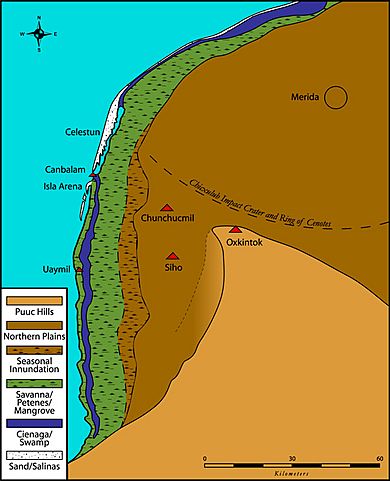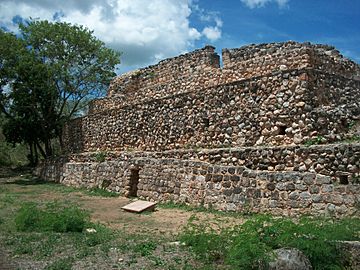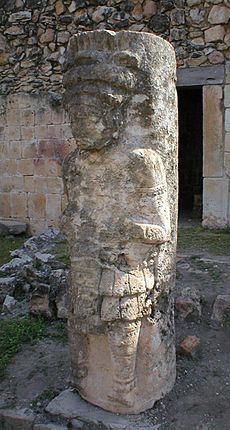Oxkintok facts for kids
Oxkintok is an ancient Maya city in southeastern Mexico. It is an important archaeological site in the Puuc region of the Yucatán state. This area is known for its unique hills and ancient Maya ruins.
Contents
Exploring Oxkintok: Where is it?
The ancient city of Oxkintok is located on the northwestern tip of the Yucatán Peninsula. It is quite close to two other historical sites, which is unusual for this area. Oxkintok is about six kilometers southeast of Maxcanu. It is also 46 kilometers northeast of Uxmal and 50 kilometers south of Mérida, the capital city today.
The Puuc Hills: A Unique Landscape
Oxkintok is in the Puuc region. In the Maya language, "puuc" means "hill." The Puuc hills stretch from southern Yucatán into Campeche and Quintana Roo. These hills are a rare sight in the mostly flat landscape of the Yucatán.
Water in the Yucatán: Caves and Cenotes
The Yucatán is a flat area made mostly of limestone. This type of land has no major rivers or lakes on the surface. Water drains underground through the limestone. This creates many caves and sinkholes called cenotes. People in ancient times, and even today, used these cenotes to get fresh drinking water. The hills in the Puuc region are not very high, never reaching more than 400 meters above sea level.
Weather in Oxkintok: Rainy Summers
The northern Yucatán has a tropical climate with heavy summer rains. Most of the rain falls between May and October. Oxkintok gets a good amount of rain, about 700mm each year. The temperature is usually around 25°C (77°F) all year, with slightly warmer temperatures near the coast.
What Does "Oxkintok" Mean?
The name "Oxkintok" comes from the Yucatec Maya language. "Ox" means "three," and "Kin" means "day" or "sun." The meaning of "Tok" is a bit trickier. It could mean "snatch away," "defend," "lean," "fall," "burn," "puncture," "let blood," or "hard stone." Because of these different meanings, you might find various translations for the name.
Uncovering the Past: Research at Oxkintok
People have been studying Oxkintok for a long time. The site was first described in the 1500s by Brother Antonio de Ciudad Real. He noticed the large ruined buildings and the famous "Satunsat" structure. He wrote that Satunsat was a place where people who did bad things were sent to die.
Early Explorers and Digs
The site was visited again in the 1800s by explorers like John Lloyd Stephens and Frederick Catherwood. They explored the Labyrinth, which is a famous building at Oxkintok. In the early 1900s, Edwin M. Shook from the Carnegie project spent some time there. The first real excavations started in 1895, focusing on the Satunsat building.
Modern Discoveries: The Oxkintok Project
Since the 1980s, a big project led by Miguel Rivera Dorado from Spain has gathered a lot of information about Oxkintok. More recently, Mexico's INAH (National Institute of Anthropology and History) has been working on digging up and rebuilding parts of the site.
The Oxkintok Project, from 1986 to 1991, was the first large-scale excavation. Its main goals were to:
- Find clues about how ancient Maya society was organized.
- Fill in gaps in our understanding of how the first civilizations in the Northern Yucatán developed.
This project has led to many books and articles about Oxkintok.
Oxkintok Through Time: A Timeline
Oxkintok was lived in for a very long time, from about 600 BCE (Before Common Era) until around 1500 CE (Common Era). It became a very important city between the Early Classic and Terminal Classic periods. One of the earliest known Maya dates, 475 CE, was found on a stone carving at Oxkintok. The latest date found there is 859 CE.
Pottery and Periods
Archaeologists have found about 70,000 pieces of pottery and 38 complete pots at Oxkintok. The timeline of the city is mostly based on the different types of pottery found. These pottery styles changed over time.
Based on these findings, experts divide Oxkintok's history into six main phases:
- Sihil
- But
- Ichpa
- Noheb
- Ukmul
- Nak
- Tokoy
The first two phases are not very clear. Things become clearer in the Ichpa phase, which matches the Early Classic Period. During this time, colorful pottery and hieroglyphic writings appeared. In the Noheb phase, colorful pottery and stone writings disappeared, and people started building large pyramids.
During the Ukmul phase, hieroglyphics came back, and there was a lot of detailed art. The Nak phase was a high point for the city. This is when the most impressive buildings were constructed. Finally, the Tokoy phase shows a decline. Evidence of human activity almost disappears, except for pottery that looks less skilled. All signs of the city fade out completely around 1500 CE.
There is no evidence that war or hunger caused people to leave Oxkintok. Also, there is no sign that anyone lived there after it was abandoned around 1500 CE.
Amazing Buildings: Architecture at Oxkintok
The buildings at Oxkintok show a mix of old and new building styles from different Classic periods. Some buildings have slab-vaulted masonry, which is an older style. Many areas also have veneer masonry, a newer style that became popular later. Oxkintok is a great example of how Maya architecture changed over time. It even has "talud-tablero" architecture, a style often seen in central Mexican cities like Teotihuacan.
Main Building Groups
The architecture of Oxkintok is usually divided into four main groups: May, Satunsat, Ah Canul/Canul, and Dzib. These groups form the city center and are mostly made up of large, important buildings like temples and palaces. There are many more buildings at Oxkintok, but these four groups have been the main focus of excavations.
Over time, the architecture changed from simple designs to more detailed and planned geometric designs. These later buildings often had complex stucco art and stone decorations. One thing that stayed the same was the use of domes and arches for doorways and open spaces.
The Labyrinth: Satunsat
The most famous building at Oxkintok is the Tzat Tun Tzat, often called "The Labyrinth." This unique building is like a maze, designed to look like a cave. No one is completely sure why it was built. However, some recent discoveries show that many of its air shafts line up with the sun's positions. This makes some people think it was used for religious ceremonies or initiations. It was likely built in the early Oxkintok phase.
Around the 6th century, one room on the lower floor was turned into a burial chamber. The staircase to the third floor was also blocked. These changes suggest that the Labyrinth, which was once a special palace, became a more ordinary one over time.
Carved Columns: Ancient Art
Oxkintok is also famous for its human-like columns. These columns, from the Late to Terminal Classic periods, show important people, warriors, and gods. They might have been an early version of the "warrior columns" seen at later sites like Chichen Itza.
Ancient Burials: Tombs at Oxkintok
Because of past looting, only a few undisturbed tombs remain at Oxkintok. Most of these tombs were very similar. They contained mostly male burials, with only a few of unknown sex. Most were individual burials, meaning one person per tomb.
These burials were found inside the city's large buildings. The offerings found with the bodies were usually similar. They often included shell jewelry, jade mask pieces, a few obsidian tools, and tripod ceramics (pots with three legs). This suggests that only high-status individuals were buried in these special tombs.
Human Remains: Clues to Health
Many human bones have been found outside of formal burials. These bones might have been part of offerings or placed there on purpose. Many of them show signs of health problems like arthritis and a bone marrow disease called osteomyelitis. Many teeth also had severely worn-down enamel, suggesting a tough diet.
Beliefs and Power: Religion and Government
In Oxkintok, like in most Maya cities, religion, government, and architecture were closely connected. The southern part of the city seemed more important than the northern part. This is because the southern half had more religious art and a ball court.
The Center of Power
The Ah Canul group of buildings in the southern half is thought to have been the center of power. It had three large pyramids and tunnels connecting to other groups. The Dzib group was also very important because it had the ball court. Ball courts were key for showing social order, power, and the right of kings to rule.
The Sun God and City Layout
The layout of Oxkintok was closely linked to the sun's movements. For example, the Labyrinth's main entrances face east and west. This was likely done to observe the sun's path, especially during the equinoxes. The ball court also faces north-south, possibly to make the ball's movement look like the sun's yearly journey.
Experts believe the city itself was designed to represent the heavens. Kings in some carvings are shown holding symbols of the sky, connecting them to the sun god. In the Ah Canul group, you can still see images of the sun and moon, and carvings of the "governing family" called Walas. This shows how closely linked religion and power were in Oxkintok.
Building for the Future: The Idea of Construction
The constant building at Oxkintok and other Maya sites was also linked to family ties and honoring ancestors. Each new ruler would build new structures to connect themselves to the "founding fathers" of their lineage. Building was a way to show family connections and social status. Each new building confirmed a family line, honored its past, and justified its power.
Who Was in Charge?
The architecture of Oxkintok clearly shows that there was inequality and a ruling class. All the burials found were well-decorated and had similar valuable items. This suggests that only high-status people were buried there. One burial even included a skull that had been shaped, which was a common Maya practice to show high status.
Writing and Symbols: Messages from the Past
Most of what we know about writing at Oxkintok comes from the Dzib architectural group. This group includes the ball court, two staircases, and 18 stone monuments called stelae. The stelae are hard to read because they are very worn down. However, we know they are from the Late Classic period.
The second staircase mentions the Walas government, suggesting it was dedicated to them. A calendar wheel, which seems connected to the ball court ring, is also present. The ball court ring itself has a date carved on it, likely when it was built: 713-714 AD.
It's possible that more writings and symbols were lost because the limestone and sandstone building materials wear away quickly. There was also a strange "hiatus" (a break) in writing at Oxkintok between 550-650 AD, even though a lot of building was happening then. No one knows for sure why this happened.
Visiting Oxkintok Today: A Trip to the Past
The site of Oxkintok is a protected area, open to visitors for a fee. You can reach it from the nearby town of Maxcanú. It's about 62 kilometers (38.5 miles) south of Mérida on Federal Highway 180. The site does not have many facilities, but guides are usually available. Nearby, you can also explore the Calcehtok caves.
See also
 In Spanish: Oxkintok para niños
In Spanish: Oxkintok para niños




